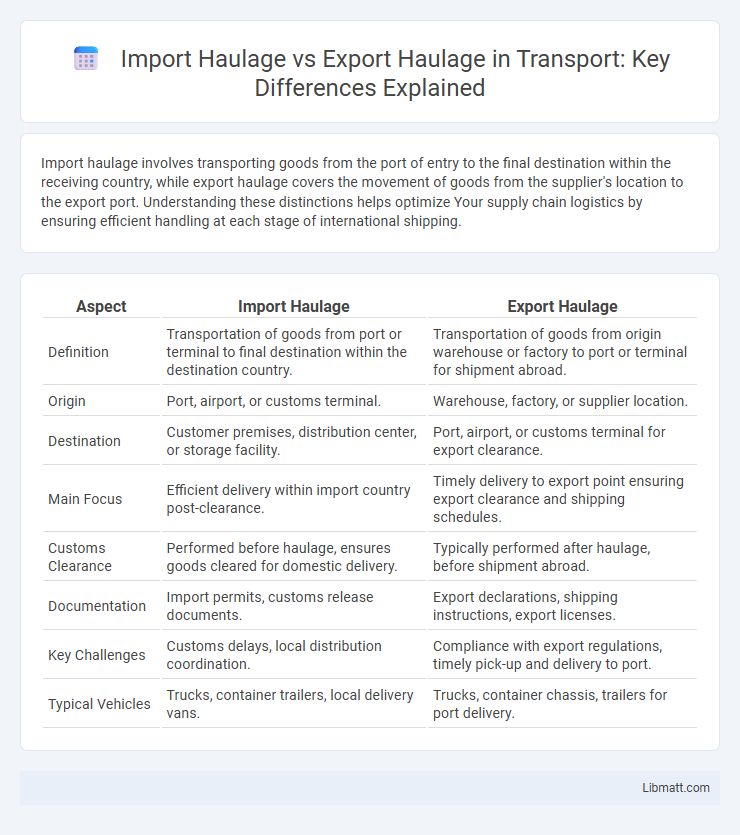Import haulage involves transporting goods from the port of entry to the final destination within the receiving country, while export haulage covers the movement of goods from the supplier's location to the export port. Understanding these distinctions helps optimize Your supply chain logistics by ensuring efficient handling at each stage of international shipping.
Table of Comparison
| Aspect | Import Haulage | Export Haulage |
|---|---|---|
| Definition | Transportation of goods from port or terminal to final destination within the destination country. | Transportation of goods from origin warehouse or factory to port or terminal for shipment abroad. |
| Origin | Port, airport, or customs terminal. | Warehouse, factory, or supplier location. |
| Destination | Customer premises, distribution center, or storage facility. | Port, airport, or customs terminal for export clearance. |
| Main Focus | Efficient delivery within import country post-clearance. | Timely delivery to export point ensuring export clearance and shipping schedules. |
| Customs Clearance | Performed before haulage, ensures goods cleared for domestic delivery. | Typically performed after haulage, before shipment abroad. |
| Documentation | Import permits, customs release documents. | Export declarations, shipping instructions, export licenses. |
| Key Challenges | Customs delays, local distribution coordination. | Compliance with export regulations, timely pick-up and delivery to port. |
| Typical Vehicles | Trucks, container trailers, local delivery vans. | Trucks, container chassis, trailers for port delivery. |
Introduction to Import and Export Haulage
Import haulage involves the transportation of goods from a foreign port to the final destination within your country, emphasizing efficient customs clearance and domestic delivery. Export haulage covers the movement of goods from your warehouse to an international port, ensuring timely pickup and compliance with export regulations. Both processes require coordinated logistics solutions to optimize supply chains and reduce transit times.
Defining Import Haulage
Import haulage refers to the transportation of goods from a port or border entry point to the final destination within the importing country. It involves managing customs clearance, local delivery logistics, and coordination with warehouses or distribution centers. Understanding import haulage helps you optimize supply chain efficiency by ensuring timely and compliant movement of inbound shipments.
Explaining Export Haulage
Export haulage refers to the transportation process where goods are moved from the seller's warehouse or production site to a port or border for international shipment. It involves managing logistics such as customs clearance, documentation, and compliance with export regulations to ensure timely delivery. Effective export haulage optimizes supply chain efficiency by coordinating carriers, handling freight consolidation, and minimizing transit times to meet global trade demands.
Key Differences Between Import and Export Haulage
Import haulage involves transporting goods from foreign ports to your domestic warehouse, focusing on customs clearance and inbound logistics management. Export haulage centers on moving goods from your location to international destinations, requiring compliance with export regulations and efficient outbound shipment coordination. Understanding these key differences ensures smooth supply chain operations and timely delivery.
Stages Involved in Import Haulage
Import haulage involves several stages, including the collection of goods from the port or warehouse, customs clearance, and final delivery to your specified destination. Each step requires coordination between freight forwarders, customs agents, and transport providers to ensure compliance and timely transit. Efficient management of these stages minimizes delays and optimizes supply chain performance.
Steps in the Export Haulage Process
Export haulage involves transporting goods from the seller's warehouse to the port of export, including steps such as documentation verification, customs clearance, and loading at the terminal. Key stages include scheduling the pickup, ensuring compliance with export regulations, securing export permits, and coordinating with freight forwarders for smooth cargo transfer. Efficient export haulage minimizes delays and ensures timely delivery to the carrier for international shipment.
Common Challenges in Import Haulage
Import haulage often faces challenges such as customs clearance delays, complex regulatory compliance, and fluctuating transportation costs, which can impact delivery timelines. Navigating port congestion and managing inventory synchronization are additional hurdles that disrupt smooth import operations. Your logistics strategy must address these issues to ensure efficient and cost-effective import haulage.
Typical Issues in Export Haulage
Export haulage commonly faces challenges such as customs clearance delays, documentation errors, and strict compliance with international trade regulations. Inefficient coordination between exporters, freight forwarders, and carriers can lead to shipment delays and increased costs. Your ability to anticipate these issues and streamline communication is critical for smooth export logistics.
Cost Comparison: Import vs Export Haulage
Import haulage typically incurs higher costs due to customs clearance fees, taxes, and longer transit times compared to export haulage, which often benefits from streamlined outbound procedures. Export haulage costs are generally lower because exporters may negotiate favorable shipping rates and fewer import-related charges. Understanding these cost differences helps you optimize logistics budgets and select the most cost-effective haulage solutions for your supply chain.
Choosing the Right Haulage Method for Your Logistics Needs
Selecting the right haulage method depends on whether you are managing import haulage or export haulage, as each involves distinct customs procedures and delivery timelines. Import haulage requires efficient coordination from the port to your warehouse, ensuring compliance with import regulations and timely distribution. Export haulage focuses on preparing goods for international shipment, optimizing loading procedures, and meeting exporter documentation requirements to avoid delays.
import haulage vs export haulage Infographic

 libmatt.com
libmatt.com